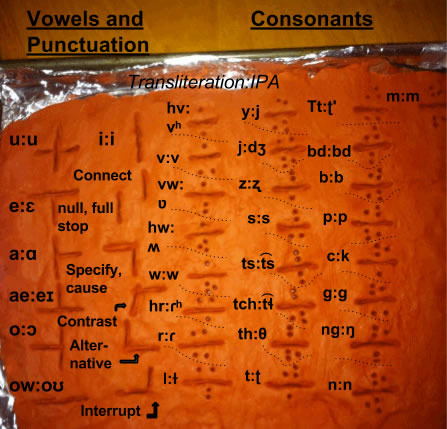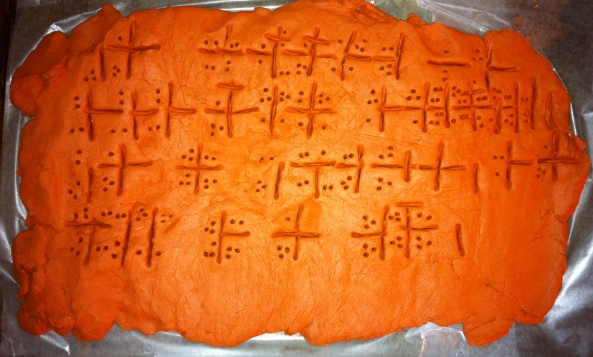
Anthony Hilton invented Greli to write Lezuli as part of a larger world-con project underway since 2011. Greli translates to "writing system" (lit. "symbol-idea"); in its own context, it isn't a proper noun, but may be as the name of a conscript. Greli had several previous incarnations using triangles and Xs for the vowels with a variety of forms for consonants, but to present crosses and dots have shown the most advantage.
By design, Greli takes clay as its medium. To that extent, it is influenced by the concept of cuneiform writing, although no study of historical cuneiforms informed its development. Similarly, Hilton's notion that one might invent a language traces to Omniglot.com. For Lezuli in general, Wikipedia's IPA charts and recordings and wals.info's data and analyses were simply indispensible. The gmail address 831ACH would accept questions on topics related to the above.

The character listed as " Tt:ʈ' " is a digraph but the first letter is never lower case. The apostrophe in the IPA is specifically IPA for an ejective, not anything else an apostrophe may indicate elsewhere.

Tchwu RaelHvosWuvaTtyo vwowta sasasaWuciczuc TacorrocRultyojli. Tchwu Ttup baj jrevyojPowu. Hrawu berlicic baj wu moBaj.
All human beings are born free and equal in dignity and rights. They
are endowed with reason and conscience and should act towards one another in a spirit of brotherhood.
(Article 1 of the Universal Declaration of Human Rights)
Constructed scripts for: Ainu | Arabic | Chinese languages | Dutch | English | Hawaiian | Hungarian | Japanese | Korean | Lingala | Malay & Indonesian | Persian | Tagalog / Filipino | Russian | Sanskrit | Spanish | Taino | Turkish | Vietnamese | Welsh | Other natural languages | Colour-based scripts | Tactile scripts | Phonetic/universal scripts | Constructed scripts for constructed languages | Adaptations of existing alphabets | Fictional alphabets | Magical alphabets | A-Z index | How to submit a constructed script
[top]
You can support this site by Buying Me A Coffee, and if you like what you see on this page, you can use the buttons below to share it with people you know.

If you like this site and find it useful, you can support it by making a donation via PayPal or Patreon, or by contributing in other ways. Omniglot is how I make my living.
Note: all links on this site to Amazon.com, Amazon.co.uk
and Amazon.fr
are affiliate links. This means I earn a commission if you click on any of them and buy something. So by clicking on these links you can help to support this site.
[top]